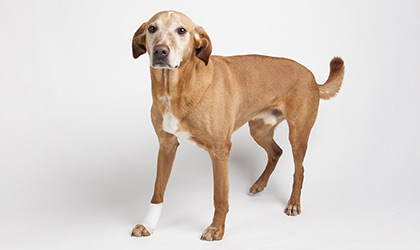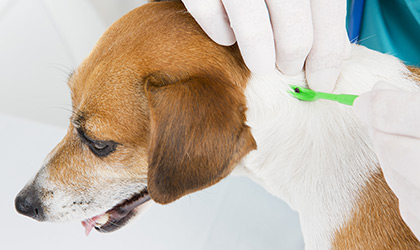
As pet owners, it’s only natural to question how human commodities can affect our feline and canine companions. We know dogs shouldn’t eat chocolate, and cats should avoid high quantities of tuna, but what about essential oils – are they really safe to use on our beloved companions? Well, in a word: yes. If used carefully (and exercising caution is especially key here, but more on that later), aromatherapy can be beneficial to for the entire family – pets and all. From busting anxiety to repelling critters, essential oils offer a natural solution for furry friend and human alike. Fancy indulging your curiosity? Here’s everything you need to know about using essential oils with your four-pawed friends.
So, what’s all the fuss about?
Smell – one of our most basic, primitive senses – can sharply influence our mood; ‘good’ smells soothe and comfort us, while ‘bad’ smells revolt and disgust us. Doesn’t the scent of freshly baked bread fill you with warmth and fuzziness? Pets draw on their immense sense of smell to better understand their environment and gauge what state of response they should assume.
Essential oils contain pretty powerful compounds, which can explain their age-old, highly esteemed reputation. Even small amounts can have far-reaching biological effects on the body. Lavender oil, for instance, is known to trigger a calming sensation in the brain, so it can be a useful way to comfort tentative pets. Used correctly, aromatherapy can play a supporting role in caring for your furry friends.
Essential oils to consider
-
Lavender (a.k.a. the Queen of essential oils): Useful for conditioning pets to feel safe (some vet surgeries even diffuse it to reassure panicky pets); may also help with insomnia, car ride anxiety, allergies and burns; most pets respond well to this oh-so-soothing essence.
-
Lemongrass & Citronella: Brilliant pest protection against fleas and ticks; use diluted in an aromatherapy diffuser.
Essential oils to avoid
The essential oil world offers a myriad of plant-based, herbal wonders, all boasting impressive healing properties. But while some bode well for our pets, others don’t – and could even prove to be very dangerous if used inappropriately. Certain aromatic essences can cause kidney and liver toxicity in sensitive pets. Cats are particularly sensitive to those containing polyphenolic compounds because they interact with the liver detoxification process. Exercise extra caution when using ‘hot oils’ like tea tree, thyme, oregano and cinnamon around your feline friends. Pooches aren’t exempt either – some essential oils can trigger tail-spinning reactions in them too. Juniper, anise, clove and thyme are known to incite allergies and skin sensitivities, and interfere with natural bodily processes. If you’re using these essences for your own wellbeing, always be mindful of your pets. Be sure to keep them are out of the room when diffusing such oils. And if you wear these essences on pulse points during the day, pay extra care when grooming and petting your companions. Oh, and always wash your hands after handling oils to avoid getting them into your pet’s delicate eyes and ears.
Using essential oils
Pets are renowned for their heightened sense of smell, hence the need for extra caution when using essential oils. Bottom line: always dilute aromatic essences; never use them neat (undiluted). Aim for one drop of the essence in 50 drops of carrier oil (Grapeseed oil works a treat). When diffusing oils, try to provide an ‘escape route’ for your pets – an open window or door, for instance. Don’t always assume pets will respond to your choice of essential oils in the same way you do. You could love the floral scent of Rose Geranium wafting through your house, but your cat may run a mile. If your furry friend doesn’t like a particular essence, don’t enforce its use. Cats are especially sensitive, so diffuse them sparingly and keep a watchful eye on your feline’s behaviour. Finally, any topical use of essential oils should only ever be used on dogs – not cats, due to their sensitive metabolic system. Spot treatment on canines needs to be handled with the utmost care and consideration, as you would with a child.
Quality matters
By now, you’ve probably gathered essential oils are highly potent stuff. All owners should adhere to the principles of safety. Always use them with great care around your pets, so you don’t unwittingly harm them. As a rule of thumb: try to purchase therapeutic grade oils from reputable companies. Cheap, low-quality products may contain adulterants and contaminants that can trigger nasty reactions in your furry friends.
Storing essential oils
Animals are curious creatures and boy, do they love exploring. Always store your essential oils far, far, far away from your pets. If your beloved companion gets his paws on your aromatic essences and ingests large amounts, it can be extremely serious for obvious reasons. Keep your oils high and out of reach, in a pet-proof, impenetrable container.
Take home message
Humans have long enjoyed the powerful healing properties of essential oils – and now, pets can benefit from them too. When used appropriately, such oils can alleviate countless health issues in our furry friends – anxiety, insomnia and skin irritation, to name a few. But exercising safety is key here. Remember, not only do domestic animals have an extraordinary sense of smell, but also they’re highly sensitive to certain oil strains. As such, you must use pet aromatherapy with great care and consideration. Quality and quantity are important too: opt for therapeutic-grade oils where possible, and use them frugally – don’t ever saturate your pet’s living quarters with a fragrance; less is always best and give your pets regular breaks. Above all, consulting a registered veterinarian is always the safest option before using essential oils with your furry companions.
Key points to remember:
-
Never apply neat essential oils to animals
-
Don’t add essential oils to drinking water or give them orally
-
Always purchase 100%, therapeutic grade essential oil – not a fragrance oil
-
Only use essential oils topically on dogs, as they can be extremely toxic on cats
-
Don’t apply oils to a pet’s muzzle area, inside ears, nostrils, mouth or eyes
-
Any topical application should be used very sparingly on animals
-
Always monitor your pet both during and after essential oil use
-
If your furry friend has been exposed to toxic essential oils, they may display signs of poisoning. Symptoms include lack of appetite, difficulty breathing, depression, vomiting, diarrhoea, twitching and seizures. If you suspect this, consult your vet immediately.
-
Avoid diffusing oils for long periods of time. Give your pet regular breaks.
-
Keep essential oils far away from animals – they can be toxic if ingested
References:
-
Azzaro, K. (2013). Animal Aromatherapy and Essential Oil Safety. NAHA. Available online: https://naha.org/assets/uploads/Animal_Aromatherapy_Safety_NAHA.pdf
-
Pet Sci. (2017). Are essential oils safe for dogs? Available online: https://petsci.co.uk/advice/essential-oils-safe-dogs/



